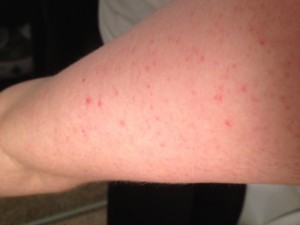Do you have a co-worker that you think might have keratosis pilaris? Maybe you wonder if one of your friends or classmates has it, or possibly you’re wondering if you have KP yourself. Regardless of why, many people who’ve heard of this condition but aren’t familiar with it or it’s symptoms are wondering exactly what it really is and what it looks like.
Keratosis pilaris is a skin condition that effects nearly forty percent of the population, both male and female as well as effecting nearly sixty percent of teenagers and adolescents. It much more common among pregnant women, and teens. Typically, hormonal changes in the body will cause more KP outbreaks and symptoms.
Keratosis pilaris normally shows up as small bumps on the skin (normally the size of “goosebumps”). Sometimes referred to as “chicken skin”, KP normally also causes the affected area of the skin to become red and irritated looking.

The most common areas that KP is seen are on the arms (especially the upper arms), thighs, knees and buttocks. It can however show up on any area of the body except for the palms and balls of the feet.
The above listed symptoms are generally the most typical and commonplace, however in extreme and / or severe cases of KP, the “bumps” can grow to be much larger and the skin may also discolor into colors other then red (in these rare cases, tan, brown or grey are most commonly seen).
If you’re wondering if the bumps that you’re seeing are keratosis pilaris or not you may want to have a look through our keratosis pilaris pictures section to see many different examples of KP, as well as other skin conditions that are often mistaken for KP.
Recently, an all natural treatment for keratosis pilaris has been getting a lot of national media attention. Many people are attributing their being KP free to this new system, which uses commonly available ingredients that can be bought at any grocery store. You can learn more about it here.